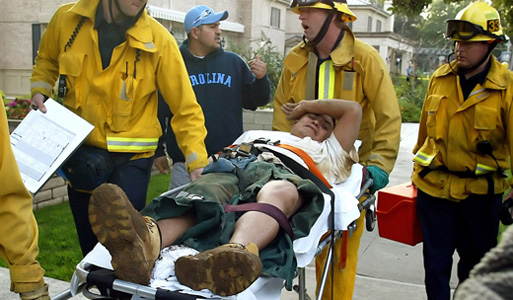
WASHINGTON (PAI) – The Labor Department’s Inspector General is still finding holes in enforcement programs of the Mine Safety and Health Administration (MSHA) and the Occupational Safety and Health Administration (OSHA). That includes times where MSHA inspectors claimed they went into coalmines with every shift, but didn’t. And 84% of worksites that OSHA called the worst of the worst weren’t inspected.
Despite those criticisms, Deputy Inspector General Daniel Petrole’s report still recommends that Congress clarify MSHA’s authority to close a dangerous mine after a fatal accident occurred, even if the closure has to be ordered verbally on the spot, to save lives. He has no such large recommendations for OSHA.
The holes Petrole found are important, as both agencies are chronically short-staffed, and rely on industry compliance, with enforcement the stick to mandate it, thus improving worker safety. When enforcement breaks down, industry can get away with law breaking. Sometimes, though Petrole did not say so, it can get away with murder.
And MSHA still has some inspection problems, Petrole says. So does OSHA.
“The (Mine) act states that an authorized representative of the secretary, when present, may issue such orders as he deems appropriate to insure the safety of any person in the coal or other mine,” Petrole said in his semiannual report to Congress for the six months ending Sept. 30.
“The primary purpose of the Mine Act is to give” MSHA “the authority to take appropriate action- including ordering a mine closure – to protect lives. As such, the Office of Inspector General recommends a technical review of the existing language…to ensure MSHA’s long-standing and critically important authority to take whatever actions may be necessary, including issuing verbal mine closure orders, to protect miner health and safety is clear and not vulnerable to challenge.”
“Although there were significant improvements since our review in 2007, MSHA continues to face challenges in administering a successful accountability program,” said Petrole. “One of the 14 recommendations in our 2007 audit – to develop and implement a tracking system” of whether and when mine companies actually fixed problems “was not fully implemented in one district.
If it can’t track fixes, or lack of them, “MSHA runs an increased risk of failing to identify systemic and recurring deficiencies, as well as instances in which corrective actions have not been implemented.” Those corrections would save miners’ lives.
“We also found that a number of high-risk deficiencies identified by MSHA’s own accountability reviews during 2009 recurred during 2010 and 2011 at one or more of the four districts we sampled. Those deficiencies included inadequate documentation, failing to conduct safety and health inspections on all working shifts, and lack of supervisory reviews” of mine inspectors’ work, the audit said. “MSHA did not implement – or could not demonstrate it had implemented – 10% of corrective actions required by the accountability role in our sample.
“MSHA has made recent changes to its organizational and reporting structure, as well as revisions to its policies and procedures to improve the accountability program,” Petrole conceded. He passed no judgment on the effectiveness of those changes, instituted by President Obama’s MSHA administrator, Joe Main, a former safety and health official at the Mine Workers and a former working miner.
OSHA is a different story, Petrole’s report adds. It also may be worse.
In 1999, the waning years of the Clinton administration, OSHA set up a Site Specific Targeting (SST) program to go after the worst of the worst and target them for inspections. Except the data in Petrole’s report show that it often didn’t.
SST was supposed to focus enforcement in on “general industry (non-construction) worksites reporting the highest injury and illness rates. In addition to SST, OSHA has national and local emphasis inspection programs to target high-risk hazards and industries. The SST program selects worksites based on injury and illness rates calculated from employer responses to annual surveys,” the audit explains.
But when the Inspector General’s office looked to see if that’s what OSHA did, they found it wasn’t. From August 2010-September 2011, “13,827 worksites met the SST program’s high-risk targeting criteria, and 2,146 were inspected,” the audit says.
“SST…did not target some of the highest-risk industries and worksites where the most serious injuries and illnesses occurred,” the auditors found. There were two reasons: One-quarter of the worksites with the most injuries and illnesses were outside the OSHA law, such as government worksites or airline cabins. And 84% of worksites that were targeted were not actually inspected due to limited resources and competing local priorities and other targeting strategies.”
OSHA offices also did not make the inspections of the worst of the worst a top priority, Petrole said. “While the SST program is a national program, neither OSHA area offices nor state plan states were required to conduct SST inspections,” he said.
Petrole’s report did not touch on employer resistance to MSHA or OSHA inspections, or to the delays companies use to halt or hobble enforcement, particularly at MSHA. He also expressed no opinion on the size of OSHA fines and penalties, which organized labor has consistently said are so low they do not a prop firms from breaking the law and injuring workers.
Petrole wants OSHA to consistently emphasize inspecting the high-risk worksites in the most-dangerous industries. OSHA agreed, but in October it asked for more time to study the issues. President Obama’s OSHA Administrator, Dr. David Michaels, is pushing a program to get firms to develop and impose strong safety programs in advance, thus preventing injuries and illnesses before they occur.
Business resistance and congressional Republican budget cuts threaten his initiative.
OSHA should “prioritize and complete inspections of the highest risk worksites to ensure effective and efficient use of resources, and complete the evaluation of the SST program and implement a monitoring system to evaluate efficiency and effectiveness of the program on an ongoing basis,” Petrole’s report says. “OSHA partially agreed with our recommendations, but indicated it would like to study these issues further before making any major policy changes.”
Photo: Construction worker is transported to an ambulance after being pulled to safety following a trench collapse at a job site. Keith Birmingham /The Pasadena Star-News/AP












Comments